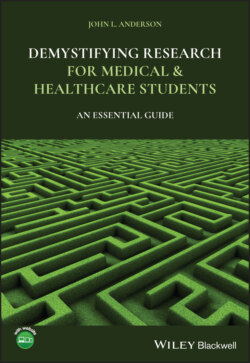Читать книгу Demystifying Research for Medical and Healthcare Students - John L. Anderson - Страница 54
Phase I Clinical Trials
ОглавлениеPhase I clinical trials are those studies where we are testing a diagnostic procedure or a treatment for the first time in humans. Previous studies will have been done on potential new medicines in laboratories on chemical, biological specimens, and animals. Now it is time to try these out in ‘real life’ on human subjects. And the first issue to be addresses is: ‘How safe are they?’ The second issue relates to ‘How much can we safely give?’ So Phase I clinical trials used to be designed to test:
1 The safety of the new drug – what are the side effects if any?
2 What is a safe dose range we can give – what is the Maximum Tolerable Dose (MTD)?
They did not use to be concerned with effectiveness. However, there has been a gradual shift over the past years (in my view to help accelerate the process for the drug companies) to include wider goals for these trials, and the Health Research Authority (HRA ) defines them as such:
A Phase 1 trial is usually the first time that an IMP is tested in humans and so it will usually investigate the safe dose range and potential side effects, how it is metabolised and whether it might work in patients.
(My italics, HRA 2020)
The HRA website is one of my favourites! I can spend days browsing it. In 2016, when it was first being set up, I used to spend hours and hours going round and round in circles trying to find out what approvals were needed for which kinds of research and trying out the decision‐making tools. I used to joke, rather bitterly then, that there were lots of tools in the HRA; but things have greatly improved and now it really is a useful website!
The shift in focus to include ‘whether it might work in patients’ reflects increasing pressure to streamline the process of developing new drugs. This has led to concerns in some circles that corners are being cut and participants' welfare may be at risk. Such trials can impose quite a burden on participants. They may have to spend considerable time as residents in the test centre. They may be subjected to many tests – often invasive such as endoscopies and lumbar punctures. Healthy volunteers are normally paid a fee. (Many students do this in their holidays to earn money.) Matt Lamkin and Carl Elliot give an account of a strange situation in the 1960, when two comedy presenters approached a naïve man on the street and made him a bizarre offer:
Posing as the hosts of a radio program called ‘Job Opportunities’, Jim Coyle and Mal Sharpe explained that they needed an employee for a new tourist attraction. In this attraction, the employee would be confined to a flame‐filled pit where he would try to fight off bats, snakes, and maniacs. ‘What we're trying to do, really, is create a living hell’, Coyle explained. ‘Have people pay admission; they look down in the pit; they see you down there; the flames are all around you. There will be four maniacs with you and you've got to control them’. Then Sharpe asked the prospective employee, ‘Have you ever worked with maniacs before?’ ‘No, never’, the man said. In exchange for spending twelve hours a day fighting maniacs, the employee would be paid $46 a week, plus one meal a day – bat meat, which the employee would be expected to grill in the flames. The job would carry some risks, Coyle explained. ‘I had an employee before, and I will tell you this directly and honestly, he was a little careless and incautious – I gave him specific instructions – and he perished’, Coyle says. ‘Now I want you to understand this before we get any further. He did perish’. The man was undeterred. ‘Yeah, I'd like to try it’, he said, sticking with his decision even when Sharpe reminded him that the death index for the job was 98%. ‘In other words’, Sharpe said, ‘if you took this job the odds would be 98% in favor of your perishing’. The man replied, ‘It's a chance. I like to take chances’.
(Lamkin and Elliot 2018)
I think the point they are making is that some people will volunteer for, or take very low pay for, dangerous work which has a risk of them not surviving it – very much like Phase 1 trials.
